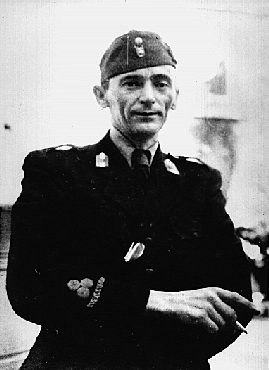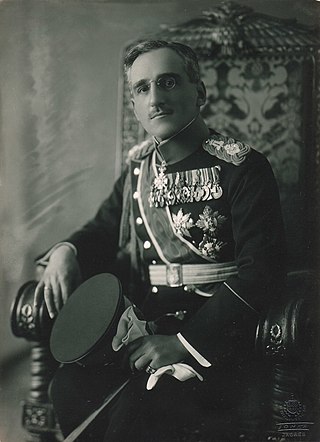Related Research Articles
The Ustaše, also known by anglicised versions Ustasha or Ustashe, was a Croatian fascist and ultranationalist organization active, as one organization, between 1929 and 1945, formally known as the Ustaša – Croatian Revolutionary Movement. Its members committed regicide of the King of Yugoslavia, while later they also murdered hundreds of thousands of Serbs, Jews, Roma as well as Croatian political dissidents during World War II in Yugoslavia.

The Independent State of Croatia was a World War II-era puppet state of Nazi Germany and Fascist Italy. It was established in parts of occupied Yugoslavia on 10 April 1941, after the invasion by the Axis powers. Its territory consisted of most of modern-day Croatia and Bosnia and Herzegovina, as well as some parts of modern-day Serbia and Slovenia, but also excluded many Croat-populated areas in Dalmatia, Istria, and Međimurje regions.
Clerical fascism is an ideology that combines the political and economic doctrines of fascism with clericalism. The term has been used to describe organizations and movements that combine religious elements with fascism, receive support from religious organizations which espouse sympathy for fascism, or fascist regimes in which clergy play a leading role.

Catholic clergy involvement with the Ustaše covers the role of the Croatian Catholic Church in the Independent State of Croatia (NDH), a Nazi puppet state created on the territory of Axis-occupied Yugoslavia in 1941.

Jure Francetić was a Croatian Ustaša Commissioner for the Bosnia and Herzegovina regions of the Independent State of Croatia (NDH) during World War II, and commander of the 1st Ustaše Regiment of the Ustaše Militia, later known as the Black Legion. In both roles he was responsible for the massacre of Bosnian Serbs and Jews. A member of Ante Pavelić's inner circle, he was considered by many Ustaše as a possible successor to Pavelić as Poglavnik (leader) of the NDH. He died of wounds inflicted when he was captured by Partisans near Slunj in the Kordun region when his aircraft crash-landed there in late December 1942.

Ljubomir "Ljubo" Miloš was a Croatian public official who was a member of the Ustaše of the Independent State of Croatia (NDH) during World War II. He served as commandant of the Jasenovac concentration camp on several occasions and was responsible for various atrocities committed there during the war. He fled Yugoslavia in May 1945 and sought refuge in Austria. In 1947, he returned to Yugoslavia with the intention of starting an anti-communist uprising. He was soon arrested by Yugoslav authorities and charged with war crimes. Miloš was found guilty on all counts and hanged in August 1948.

Vjekoslav Luburić was a Croatian Ustaše official who headed the system of concentration camps in the Independent State of Croatia (NDH) during much of World War II. Luburić also personally oversaw and spearheaded the contemporaneous genocides of Serbs, Jews and Roma in the NDH.

Andrija Artuković was a Croatian lawyer, politician, and senior member of the ultranationalist and fascist Ustasha movement, who served as the Minister of Internal Affairs and Minister of Justice in the Government of the Independent State of Croatia (NDH) during World War II in Yugoslavia. He signed into law a number of racial laws against Serbs, Jews, and Roma, and was responsible for a string of concentration camps in which over 100,000 civilians were tortured and murdered. He escaped to the United States after the war, where he lived until extradited to Yugoslavia in 1986. He was tried and found guilty of a number of mass killings in the NDH, and was sentenced to death, but the sentence was not carried out due to his age and health. He died in custody in 1988.

The Genocide of Serbs in the Independent State of Croatia was the systematic persecution of Serbs which was committed during World War II by the fascist Ustaše regime in the Nazi German puppet state known as the Independent State of Croatia between 1941 and 1945. It was carried out through executions in death camps, as well as through mass murder, ethnic cleansing, deportations, forced conversions, and war rape. This genocide was simultaneously carried out with the Holocaust in the NDH as well as the genocide of Roma, by combining Nazi racial policies with the ultimate goal of creating an ethnically pure Greater Croatia.

Julije Makanec was a Croatian politician, teacher, philosopher and writer. During the World War II in Yugoslavia, he was the Minister of Education of the Independent State of Croatia and a high-ranking member of the Ustashas.

Stjepan Horvat was a Croatian geodesist and professor, dean of the Technical Faculty in Zagreb, head of the University of Zagreb, editor of the journals Geodetski list and Hrvatska državna izmjera, manager of the Department for State Survey in the Croatian Headquarters for Public Affairs, member of the State Land Consolidation Commission, Air Force officer in the time of the Nazi-puppet state Independent State of Croatia, adviser at the Military-Geography Institute in Argentina for 40 years and an honorary member of the Argentine Association of Geophysicists.

The 6 January Dictatorship was a royal dictatorship established in the Kingdom of Serbs, Croats and Slovenes by King Alexander I with the ultimate goal to create a Yugoslav ideology and a single Yugoslav nation. It lasted from 6 January 1929, when the king prorogued parliament and assumed control of the state, and ended with the 1931 Yugoslav Constitution.

The Holocaust in the Independent State of Croatia involved the genocide primarily of Jews, and also the genocide of Serbs and Romani (Porajmos), within the Independent State of Croatia, a fascist puppet state which existed during World War II, was led by the Ustaše regime, and ruled an occupied area of Yugoslavia which included most of the territory of modern-day Croatia, the whole of modern-day Bosnia and Herzegovina and the eastern part of Syrmia (Serbia). Of the 39,000 Jews who lived in the NDH in 1941, the United States Holocaust Memorial Museum states that more than 30,000 were murdered. Of these, 6,200 were shipped to Nazi Germany and the rest of them were murdered in the NDH, the vast majority in Ustaše-run concentration camps, such as Jasenovac. The Ustaše were the only quisling forces in Europe who operated their own extermination camps for the purpose of murdering Jews and members of other ethnic groups.

Ante Vokić was a Croatian politician, general and putschist. Member of the Ustaše, he was the Minister of Armed Forces of the Independent State of Croatia from 29 January to 30 August 1944, succeeding Miroslav Navratil.
The Ustaše Militia was the military branch of the Ustaše, established by the fascist regime of Ante Pavelić in the Independent State of Croatia (NDH), an Axis puppet state established from a large part of occupied Yugoslavia during World War II.
Viktor Gutić was a Croatian army colonel who was an Ustaše commissioner for Banja Luka and the Grand Prefect of Pokuplje in the Independent State of Croatia (NDH) during World War II. He was responsible for the persecution of Serbs, Jews and Roma in the Bosanska Krajina region of Bosnia between 1941 and 1945, and reported to the principal commissioner for Bosnia and Herzegovina, Jure Francetić.

Zdenko Blažeković was a Croatian fascist official who held several posts in the World War II Ustaše regime in the Independent State of Croatia (NDH). He was the student commissar at the Ustaše University Centre (USS), leader of the male Ustaše Youth organisation and a sports commissioner in the NDH.
The Banski Grabovac massacre was the mass killing of 1,100-1,200 Serb civilians by the Croatian fascist Ustaše movement on 24-25 July 1941, during World War II.

The Ustaše Youth was the youth wing of the Ustaše, a Croatian fascist and ultranationalist organization active during the interwar period and World War II. The Ustaše governed a German-Italian puppet state called the Independent State of Croatia between 1941 and 1945.
References
- ↑ "Rory Yeomans". University of Pittsburgh Press.
- ↑ Stahel, David (2018). "Contributors". Joining Hitler's Crusade. Cambridge University Press. p. xiii. ISBN 978-1-31651-034-6.
- ↑ "Rory Yeomans". ias.edu. Institute for Advanced Study. 9 December 2019.
- 1 2 McMahon (2019). "Contributors". National Races: Transnational Power Struggles in the Sciences and Politics of Human Diversity, 1840-1945. University of Nebraska Press. p. 368. ISBN 978-1-49621-584-0.
- ↑ Visions of Annihilation: The Ustasha Regime and the Cultural Politics of Fascism, 1941-1945. Backcover, "Editorial Reviews". University of Pittsburgh Press.